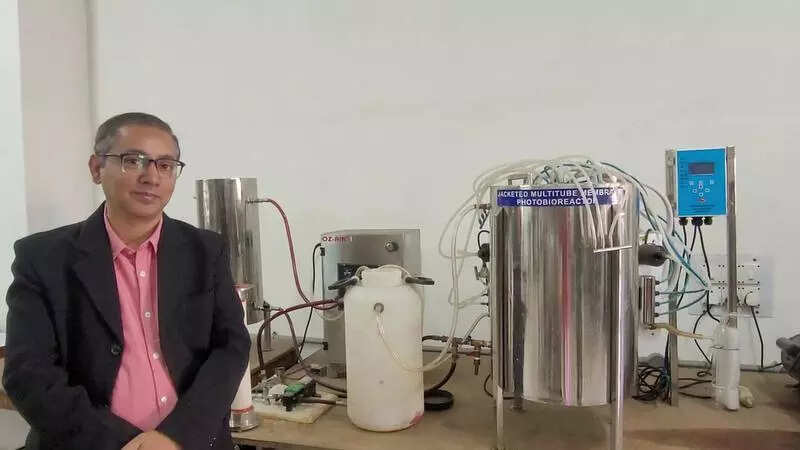NIT-R team develops process to treat industrial wastewater | Bhubaneswar News

Bhubaneswar/Rourkela: Researchers from National Institute of Technology (NIT), Rourkela, have developed a process for efficiently treating industrial wastewater contaminated with persistent dyes like Bismarck Brown R. The research team has been granted a patent for this technology.
This research, supported by the department of science and technology (DST) under the science and technology ministry, was published in the Journal of Environmental Chemical Engineering. Sujit Sen, professor of the department of chemical engineering at NIT Rourkela, research graduate Madhumita Manna, and Binay Kanti Dutta, former professor of IIT Kharagpur, developed this eco-friendly wastewater treatment system to enhance dye removal efficiency.
“Wastewater from industries like textiles and dye manufacturing often contain harmful dyes that are difficult to remove with traditional filtration methods. Dyes such as Bismarck Brown R are small enough to pass through microfiltration membranes, making them particularly challenging to treat. These dyes can cause significant environmental and health issues due to their intense colour and potential carcinogenic properties,” said Sen.
He explained that conventional treatment methods, such as those relying on ultraviolet light, often struggle with large-scale applications, especially when separating dye particles from water. “To address these challenges, we developed this cutting-edge treatment system that combines two advanced technologies. The first is a ceramic membrane coated with an industrial-waste derived zeolite and zinc oxide nanocomposite. This photocatalyst can break down dye molecules when exposed to light,” said the professor.
He said the second technology incorporates microbubbles, generated via a simple air diffuser, to enhance mass transfer and improve the breakdown process. They tested this by utilising wastes collected from industries.
The researcher said this technology could be applied across industries such as textile manufacturing, chemical industries such as steel, petrochemicals, and pharmaceuticals, where robust wastewater treatment is required. It can also be scaled up and integrated into existing wastewater treatment plants to improve the efficiency of treating dye-laden wastewater. Furthermore, the system may prove effective for treating contaminants that are typically difficult to remove using conventional methods, such as those found in hospital and pharmaceutical wastewater, he added.
Sen said they made a prototype of this advanced hybrid wastewater treatment system within one-and-a-half years. They received Rs 90 lakh for this important project in 2020. “It can be transported easily. Cost-effective and easily assembled technology. We will soon transfer technology to any interested industrial house or company that manufactures components for wastewater treatment plants. It is not for domestic purposes,” said Sen.
The lead researcher said their hybrid system achieved 95.4 per cent decolourisation of Bismarck Brown R and 94 per cent removal of chemical oxygen demand (COD) in just 90 minutes. “As a next step, the research team is actively working on scaling up this technology for broader application, with the goal of improving industrial wastewater treatment while maintaining environmental sustainability,” said Sen.
This research, supported by the department of science and technology (DST) under the science and technology ministry, was published in the Journal of Environmental Chemical Engineering. Sujit Sen, professor of the department of chemical engineering at NIT Rourkela, research graduate Madhumita Manna, and Binay Kanti Dutta, former professor of IIT Kharagpur, developed this eco-friendly wastewater treatment system to enhance dye removal efficiency.
“Wastewater from industries like textiles and dye manufacturing often contain harmful dyes that are difficult to remove with traditional filtration methods. Dyes such as Bismarck Brown R are small enough to pass through microfiltration membranes, making them particularly challenging to treat. These dyes can cause significant environmental and health issues due to their intense colour and potential carcinogenic properties,” said Sen.
He explained that conventional treatment methods, such as those relying on ultraviolet light, often struggle with large-scale applications, especially when separating dye particles from water. “To address these challenges, we developed this cutting-edge treatment system that combines two advanced technologies. The first is a ceramic membrane coated with an industrial-waste derived zeolite and zinc oxide nanocomposite. This photocatalyst can break down dye molecules when exposed to light,” said the professor.
He said the second technology incorporates microbubbles, generated via a simple air diffuser, to enhance mass transfer and improve the breakdown process. They tested this by utilising wastes collected from industries.
The researcher said this technology could be applied across industries such as textile manufacturing, chemical industries such as steel, petrochemicals, and pharmaceuticals, where robust wastewater treatment is required. It can also be scaled up and integrated into existing wastewater treatment plants to improve the efficiency of treating dye-laden wastewater. Furthermore, the system may prove effective for treating contaminants that are typically difficult to remove using conventional methods, such as those found in hospital and pharmaceutical wastewater, he added.
Sen said they made a prototype of this advanced hybrid wastewater treatment system within one-and-a-half years. They received Rs 90 lakh for this important project in 2020. “It can be transported easily. Cost-effective and easily assembled technology. We will soon transfer technology to any interested industrial house or company that manufactures components for wastewater treatment plants. It is not for domestic purposes,” said Sen.
The lead researcher said their hybrid system achieved 95.4 per cent decolourisation of Bismarck Brown R and 94 per cent removal of chemical oxygen demand (COD) in just 90 minutes. “As a next step, the research team is actively working on scaling up this technology for broader application, with the goal of improving industrial wastewater treatment while maintaining environmental sustainability,” said Sen.
















